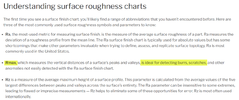S
Scotticusprime
The company I work for has a manufacturing process that is causing longitudinal and transverse scratches on the outside surface of a cylindrical, carbon-alloy part. The standard specification for this part defines the acceptable surface finish, but does not define acceptance/rejection criteria for discontinunities - like scratches.
Several people at my company and at a related company are wanting to measure the scratches using a surface roughness gauge (Surftest SJ-201P) to accept/reject the parts. My understanding is that this would be a misuse of the tester, because it is designed to take several samples of the surface roughness and provide an "average", essentially removing outliers like a scratch.
The conversation is not going well. Please help me explain why the surface roughness gauge is not going to work. Also, I am open to the possibility that I am wrong.
Secondly, I am setting acceptance/rejection criteria for these scratches (depth,width,length) and I am looking for a device that will measure these aspects. So far, I am looking at optical micrometers for measuring scratch depth? What can used to measure width?
Regards.
Several people at my company and at a related company are wanting to measure the scratches using a surface roughness gauge (Surftest SJ-201P) to accept/reject the parts. My understanding is that this would be a misuse of the tester, because it is designed to take several samples of the surface roughness and provide an "average", essentially removing outliers like a scratch.
The conversation is not going well. Please help me explain why the surface roughness gauge is not going to work. Also, I am open to the possibility that I am wrong.
Secondly, I am setting acceptance/rejection criteria for these scratches (depth,width,length) and I am looking for a device that will measure these aspects. So far, I am looking at optical micrometers for measuring scratch depth? What can used to measure width?
Regards.


